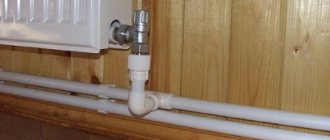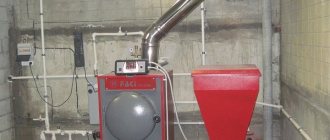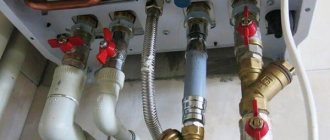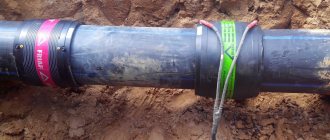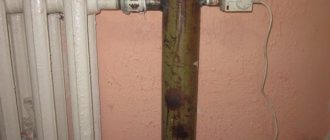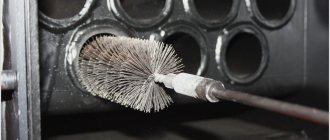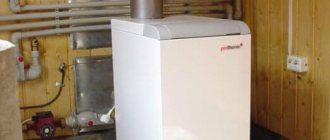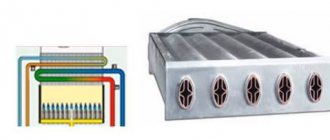Polypropylene pipes in heating systems
Fittings and pipes made of polypropylene (PPR) are popular due to their low cost and ease of installation. They are not subject to corrosion, have smooth internal walls and serve no less than the 50 years declared by the manufacturer.
There are several types of these pipe products, which differ in technical characteristics and purpose.
In the construction of heating systems, as well as in the installation of hot water supply circuits similar to them in operational parameters, the following is used:
- Pipes marked PN 25. Products with reinforcement made of aluminum foil. Used in systems with nominal pressure up to 2.5 MPa. Operating temperature limit +95º C.
- Pipes marked PN 20. Reinforced version used in DHW branches of double-circuit heating boilers. They will work for the period stated by the manufacturer if the coolant temperature is not higher than +80º C and the pressure is not higher than 2 MPa.
- Pipes marked PN 10. Thin-walled polymer products. They are used if the boiler supplies coolant to the water heated floor system. Operating temperature not higher than +45º C, nominal pressure up to 1 MPa.
Polymer pipes are suitable for all known installation methods: open and hidden. But this material has a high coefficient of thermal expansion. When heated, such products begin to slightly increase in length. This effect is called thermal linear expansion and must be taken into account when constructing pipelines.
The boiler should be tied with polypropylene pipes, which are marked as operating class 5, operating pressure of 4–6 atmospheres and nominal pressure PN of 25 and above
To prevent destruction of polypropylene heating pipelines, compensation loops can be installed. But it’s easier to take multilayer pipes, the reinforcement in which is specifically designed to compensate for this stretching. A layer of foil inside PN 25 polypropylene pipes reduces their thermal elongation by half, and fiberglass by five times.
Image gallery
Photo from
Large diameter PP pipe welding machine
Features of welding wide plastic pipes
Connection of narrow polypropylene pipes
Apparatus for connecting small diameter PP pipes
What is boiler piping with polypropylene
Piping is the connection into a single functional complex of heating equipment, equipment systems and hot water supply, ensuring the transfer of hot water to heating devices and water points. A well-executed scheme allows you to evenly distribute heat flows to consumers and ensure reliable operation of all equipment, protecting it from overheating and the possibility of creating an emergency. Before installing heating and pumping equipment, they are calculated; only in this case will the circuit work correctly and efficiently, with operating parameters and efficiency.
You need to understand that there are no ready-made standard options for heating networks; only an individual project can be effective. However, to perform it, a certain standard set of standard equipment is used. A huge advantage of using polypropylene pipelines (PPR) is the unlimited possibilities for creating contours of any complexity. Although specialists should not abuse this, since the complexity complicates installation work and, ultimately, reduces the efficiency of the thermal power plant.
Gas boiler piping
To tie the boiler with polypropylene, you can use both welding technology and the use of fittings. The second option is less popular, since even with small “water hammer” at the installation points, leaks can occur. And although PPR can easily withstand heating fluids from temperatures up to 95 C, there are temperature restrictions that are taken into account when tying the boiler.
The connection of gas fuel to the boiler unit is rigid; SNIiP requires the use of only steel pipelines using a paronite gasket through a steel pipe or “American”.
The pipeline section at the inlet/outlet of the boiler unit up to 1 m is made of steel.
Pipe PN 10
Features of installation of PPR pipelines
When piping a boiler, polypropylene pipes and fittings are connected mainly by cold or hot welding; when connecting to metal pipelines, threaded connections are used. Screwing on is much more convenient, but because of them, assembling the system will cost significantly more.
True, if you want to connect a polypropylene pipeline to a metal counterpart, you cannot do without threaded fittings.
An extensive line of fittings is produced to form linear and nodal connections of polypropylene pipes
“Hot” welding is done with a special apparatus (soldering iron, “iron”). The pipes are heated using a suitable nozzle to a melting temperature of 260 degrees, and then the parts with softened edges are pressed against each other. The result is a reliable and monolithic connection.
Before welding, the foil of reinforced pipes must be cleaned. Otherwise, it will interfere with the connection of polymer products, making the seam fragile. With fiberglass, these unnecessary steps will not be required. It melts easily along with the plastic.
PPR soldering technology is extremely simple, all work can be done with your own hands (+)
Cold welding involves the use of a specialized adhesive composition. In recent years, this method has rarely been used, because the result is not reliable enough.
In heating systems, threaded connections should be sealed with paronite or high-temperature sealant. Do not forget about the fairly high operating temperature of the coolant.
There is one more nuance of using polypropylene for piping a heating boiler. Antifreeze and plastic are a pretty bad combination. It is recommended to use water as a coolant for a system of plastic pipes.
Which strapping scheme do you prefer?
The property owner decides which heating system design option to choose, but he must take into account the purpose of the circuit that is planned to be installed:
- the simplest diagram, when you do it yourself, piping a wall-mounted single-circuit boiler (more details: “Single-circuit heating system: diagram”), with a gravity system is ideal for a small country building (more details: “Calculation of the gravity heating system of a private house – diagram”);
- complex boiler piping schemes with many functional devices are needed to provide heating in houses with warm water floors and non-centralized hot water supply.
Owners of private houses will need knowledge regarding the construction of the network in order to promptly detect problems in the operation of the heating system.
Selecting a heating system wiring diagram
There are several options for lining the boiler with polypropylene. This scheme is selected individually for each house. What is optimal in one building may be ineffective in another.
In addition, heating systems based on the principle of water movement are divided into: forced with a hydraulic pump and gravity (gravity, natural), there is also a classification based on the construction of pipelines. According to their structure, they are single- and double-pipe, collector beam or analogues with closed rings.
Which is better: gravity or pump?
In the gravity circuit, heated water flows from the boiler to the radiators by gravity. A hot coolant that has a high temperature always tends to replace a colder liquid. This heating boiler piping system is the easiest to assemble. In addition to the heater, it contains polypropylene pipes, radiators and an expansion tank.
In the version with top distribution, water, after heating, rises to the highest point - into the expander, and from there it goes down to the batteries. After the heat is released, it returns to the boiler, where it is heated again, then starting a new cycle.
This is how heating is installed in many houses in our country’s villages. Only there is a solid fuel stove. This is the simplest and cheapest way to organize heating for a small cottage. However, it has limitations both in the number of connected radiators and in the distance of the outermost one from the water heater.
The piping scheme with natural water movement is the simplest of all possible options, it has a minimum of nodes and connection points for polypropylene pipes
The compulsory system is more complex and expensive. However, it greatly simplifies the creation of comfortable temperatures in individual rooms. The coolant moves in it due to the stimulation of its movement by the pump.
The choice of polypropylene pipe layout and the boiler itself are closely related. The natural circulation system is energy independent. If the water heater does not require power from the electrical network, then even during power outages the house will be heated.
In a forced circuit, the pump requires a constant power supply to operate. Therefore, it is best to select a boiler for it that is dependent on electricity, which has additional capabilities. But in order to insure against voltage problems, you will have to purchase a backup generator or uninterruptible power supply.
Which heating scheme is better to choose?
There are many ways to route polypropylene pipelines from the boiler to the heating radiators.
But all these schemes are divided into:
- single-pipe;
- two-pipe.
In single-pipe systems, heated water supplied as a coolant is supplied and discharged through one pipe. In two-pipe systems for supplying coolant and return, i.e. to drain cooled water back into the boiler for heating, separate lines are constructed.
According to the method of connecting the working components, heating circuits are divided into:
- tee;
- collector
Tee types can be used for both gravity and forced circulation. The collector circuit can only work if there is a circulation pump.
A single-pipe circuit is obviously cheaper than a two-pipe circuit, but the radiator farthest in the chain from the boiler receives a minimum of thermal energy (+)
The single-pipe method involves laying one looped line and connecting batteries in series to it. In a two-pipe scheme, two independent pipelines with hot water and return flow from the boiler. And radiators are already connected to them.
With collector piping, one or two collectors are built into the system, from which separate pipes are routed to each battery. Also, such a distributor allows you to connect a “warm floor” made of the same PPR to the boiler.
Collector wiring makes it possible to create efficient heating systems for houses of large area and different number of storeys (+)
The use of collectors and separate risers for each battery leads to a significant increase in the cost of both design and installation. At the project preparation stage, more complex calculations have to be made. And during assembly, a much larger volume of polypropylene is consumed. But what we get is a system, each part of which can be adjusted to specific conditions and requirements.
Location of the boiler in the heating system
The main element in the heating circuit is the heating unit.
The scheme according to which the piping of the heating boiler will be carried out largely depends on the type of this device. The main rule for installing floor-standing models shown in the photo is that they cannot be placed at the highest point of pipe distribution. If this condition is not met, then air pockets will form in the boiler without a device for removing trapped air. In this case, the supply pipe that exits the unit should be placed strictly vertically.
The fact that an automatic air vent is built into the model of an electric or gas boiler is indicated by the presence of pipes in its lower part, to which the supply pipe and return pipe are connected. They are usually installed in electric or gas wall mounted equipment (pro
Polypropylene circuit for different boilers
Most manufacturers of water heaters recommend making the first meter of the pipeline from metal. This is especially true for solid fuel devices with a higher outlet water temperature. When piping, polypropylene should be connected to this outlet, otherwise if the boiler malfunctions, it will suffer a thermal shock and may burst.
Option #1: Gas water heater
It is recommended to piping a gas boiler with polypropylene using a hydraulic arrow and a manifold. Often, gas models are already equipped with built-in pumps for pumping water. Almost all of them are originally intended for compulsory systems.
The most reliable in terms of safety will be a scheme with circulation equipment for each circuit behind the collector.
In this case, the built-in pump will pressurize a small section of the pipeline from the boiler to the distributor, and then additional pumps will be used. They will bear the main burden of pumping coolant.
You can tie a gas boiler with polypropylene without long metal pipes; the water in such a heater rarely heats up to 75–80 degrees
If the gas boiler has a cast iron heat exchanger, then when piping it into the system, an additional heat accumulator should be installed. It will smooth out sudden changes in water temperature, which have a negative effect on cast iron. If the coolant is heated or cooled abruptly, it may even burst.
When piping a double-circuit device with parallel heating of water for domestic hot water, additional fine and coarse filters will have to be installed on this outlet. They should be mounted at the entrance to the water heater, where cold water is supplied.
Option #2: Solid fuel model
The main feature of a solid fuel boiler is its inertness when the fuel supply is stopped. Until everything in the firebox burns out completely, it will continue to heat the coolant. And this can have a detrimental effect on polypropylene.
When piping a solid fuel boiler, only metal pipes should be connected to it immediately, and polypropylene pipes can only be inserted after a meter and a half. In addition to this, it is necessary to provide a backup supply of cold water for emergency cooling of the heat exchanger, as well as its discharge to the sewer.
The section of the pipeline from the solid fuel boiler to the collector should be made of metal, and then you can tie it with polypropylene - this is the only way to protect the plastic pipes from overheating
If the system is built on forced circulation, then it will be necessary to install an uninterruptible power supply for the pump. Water must constantly remove heat from the firebox where solid fuel burns, even during power outages.
In addition to it, you can make a small gravity circuit or equip all batteries with bypasses to turn off individual sections of the system. In case of accidents, this will allow you to repair the damaged section while the heating is running.
The solid fuel boiler must be covered with a protective casing, which limits the spread of heat from the walls of the firebox into the boiler room. But even if it is present, the manifold and plastic pipes should be removed away from the stove.
Option #3: Oil and Electric Heaters
The exhaust or diesel boiler is wrapped with polypropylene according to a scheme identical to its solid fuel counterpart. The polymer must be removed from it as far as possible.
When piping an electric PPR boiler, you don’t have to worry about pipe ruptures; it has an automatic safety device that prevents the water from boiling.
Heating the coolant in an electric water heater to critical temperatures for polypropylene is practically impossible. When the voltage goes out, it simply stops working. In this case, the pipes are protected from hydraulic shocks by a hydraulic accumulator and valves to relieve excess pressure.
Creating circuits with natural circulation
Systems with such coolant movement are characterized by a simple design and can be installed independently.
This type of heating, without a pump to move the coolant, is also called gravity heating. The movement of hot coolant to heating devices and the outflow of cooled water is carried out without the use of additional mechanisms or human assistance. The simplest scheme for tying a heating boiler is usually used for heating small country buildings. It is not able to cope with the heat supply of large buildings. The optimal solution for self-installation, when piping a boiler room, is considered to be a scheme with natural circulation of water, which includes such elements as a heating boiler, heating radiators and an expansion tank (pro
Mounting options
Conventionally, all piping options are divided into 2 types, depending on the principle of coolant flow through the circuit - with natural or forced circulation.
Natural circulation systems
Systems with natural circulation do not have a pump, and its function is performed by gravity
These are simple and cheap circuits that are easy to install due to the absence of a pump. Its function is performed by gravity, which drives the coolant of small heating systems in cottages or country houses. It is easier to tie a floor-standing boiler with polypropylene in this way, since in this case the system will consist of a boiler, an expansion tank and radiators, and will have a number of advantages:
- Ease of installation;
- Autonomous operation due to the absence of connection to fuel or electricity;
- No need for special maintenance;
- Compactness;
- Reliability due to the absence of additional devices that periodically fail;
- Availability.
The only disadvantages of piping with natural circulation are difficulties in selecting pipes. The optimal diameter for them is calculated by performing certain calculations.
Due to the impossibility of adjustment, it is modernized - a circulation pump is built into it, which allows the necessary manipulations to be performed.
Forced circulation systems
In systems with forced circulation, special devices are installed that ensure the movement of the coolant
These are circuits in which the coolant moves thanks to special devices. They are convenient because they allow you to set the optimal heating mode for each room, which will be maintained automatically. They operate on electricity, and this is not their only drawback.
- They are difficult to install, as they require the connection of several devices - to take into account pressure and flow and to distribute energy when piping a wall-mounted double-circuit boiler.
- They require balancing of devices.
- Their serviceability must be checked regularly.
- Elements for such systems are not cheap.
Primary-secondary rings help simplify the diagram. By installing a circulation pump to uniformly supply coolant in each of them, you can save yourself from the need to install devices that provide protection and control over the operation of the system.
In houses with boilers with a power of over 50 kW and a “warm floor” system, when installing the piping, hydraulic arrows are used, thanks to which all devices are provided with heat in the required volume. Moreover, the pressure in different places of the system is compensated. You can replace hydraulic shooters with comb collectors.
Emergency circuits
Connecting two boilers allows the system to remain operational even if one of them fails
It is advisable to use them when piping double-circuit boilers, since they are responsible for the uninterrupted operation of heating in the event of a lack of electricity or other force majeure situations.
There are several effective options for such schemes:
- Installation of an uninterruptible power supply to drive the circulation pump. But it has its drawbacks. Such a device may not work at the right time. In addition, it requires regular maintenance - charging the batteries.
- Installation of a gravity circuit, which is necessary to remove excess heat. It turns on after the pump is turned off, but provides partial heating of the building.
- Installation of an emergency circuit. Being part of the heating system, it is responsible for the uninterrupted operation of the gravity and forced circuits, but only when the pump is turned on.
It is also worth considering the wiring diagram for two heating boilers within one system. The failure of one of them will not affect the overall performance.
Option to work with a wall-mounted boiler
Wiring a wall-mounted boiler has its advantages - you can connect a boiler and 'warm floors' to it
Its advantage is that it can be connected to “warm floors” and a boiler and can be used for a single-circuit or double-circuit boiler. In the latter case, the system can be assembled using a mixing circuit, when adjustment is carried out by a burner and a mixer with a servo drive, or in a straight line, when only the burner is activated.
It is advisable to include a heat accumulator in such a system, especially in regions where night tariffs apply. It will be able to heat water at night using cheap electricity, and distribute it during the day when it becomes more expensive.
The heat accumulator is mounted like a hydraulic arrow - between the direct supply and return.
